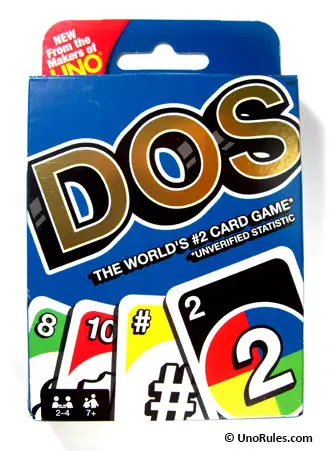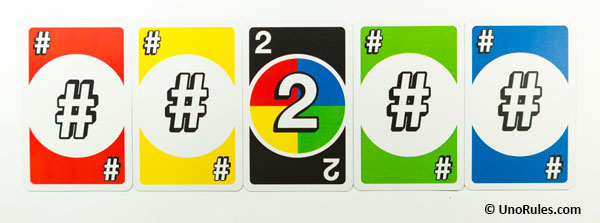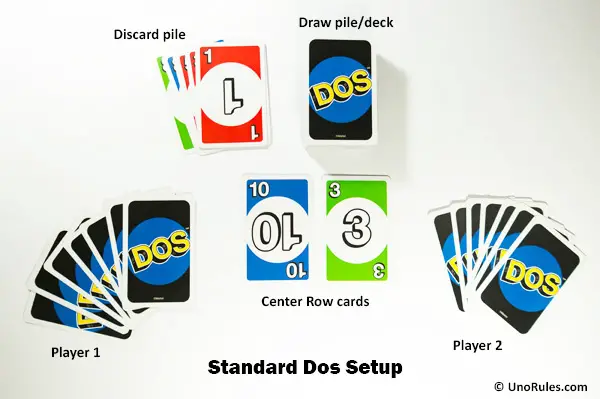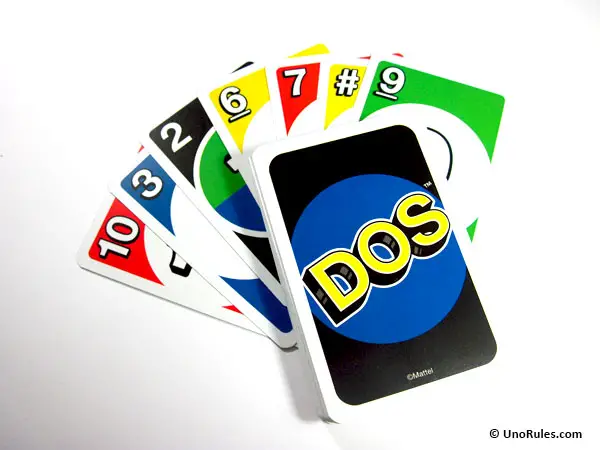 If Uno means One, then Dos means Two. Welcome to the sequel for Uno, which is Dos. Dos was launched by Mattel in early 2018 and it’s a pretty interesting card game in itself. Although there is some slight similarity between Uno and Dos, you will quickly find out that both are very different card games. Let’s take an in-depth look at Dos.
If Uno means One, then Dos means Two. Welcome to the sequel for Uno, which is Dos. Dos was launched by Mattel in early 2018 and it’s a pretty interesting card game in itself. Although there is some slight similarity between Uno and Dos, you will quickly find out that both are very different card games. Let’s take an in-depth look at Dos.
2-4 players can play Dos which is far less than for Uno. Dos has 108 cards, which consists of 96 numbered color cards (Red/Blue/Green/Yellow) and 12 Wild Dos cards. Each color has three cards of the numbers 1, 3, 4, 5, and two cards of the numbers 6, 7, 8, 9, and 10. There are also two Wild # cards for each of the four colors. Notice that there is no number 2 card for each color, but instead, the 2s have been replaced by Wild Dos cards as we will see below.
Objective
The primary objective of Dos is to discard all cards in one’s hand before anyone else does (and earn points from the cards still left in other player’s hands). Like Uno, you have to discard your cards by matching the cards in the center, but here in Dos, you can only match them by number. The numbers need to be matched first, then only the color is noted. Colors only earn a bonus called a Color Match Bonus. The first player to reach a score of 200 points (or any number the players agree on) is the game winner.
Special Wild Cards
Besides the numbered cards, Dos has special Wild cards, but these are different from the ones in Uno. The Wild cards are the colored Wild # cards (which can represent any number), and the Wild Dos cards (which are “2” cards that can represent any color).
Wild Dos card – The number 2 cards in Dos are represented by these Wild cards, which can take up any color as the player (whose current turn it is to play) sees fit. If a Wild Dos card is turned up from the Draw pile, the player whose turn it is to play can decide what color it should be.
Wild # card – The Wild # card can represent any number for its own particular color. This can be used to make up any number from 1-10, as the player (whose current turn it is to play) sees fit. If a Wild # card is turned up from the Draw pile, the player whose turn it is to play can decide what number it should be.

Dos special Wild cards are the four Wild # cards and the Wild Dos cards with the number 2 face value.
Gameplay
Appoint a dealer to deal out 7 cards to everyone. A simple way to pick a dealer is by everyone drawing a card from the deck and the person who draws the highest face number shall be the dealer (put back any Wild cards). After dealing 7 cards to everyone, place the main deck in the center to form the Draw pile/deck, and turn up two cards to be the Center Row, while leaving space for a Discard pile. Remember there must always be a minimum of 2 cards face up in the Center Row. The person to the left of the dealer can now begin play in a clockwise direction.

How do you match cards?
Cards are matched by number. Cards can be matched by Single matches and Double matches for the two cards in the Center Row. For each card in the Center Row, you are only allowed a maximum of TWO cards to match (e.g., 3 with 3, or 1+3). If there are 4 cards in the Center Row, you can match cards to ALL four of them as long as you have matching cards in your hand, but only a maximum of two per Center Row card.
Once the cards are matched, remove them and stack them into a Discard pile next to the Draw pile/deck. Turn up a new card from the Draw pile to replace the cards that just got matched in the Center Row. Here are the types of matches in Dos:
Single Match – Match cards by number, although the color would be different. Example: Match a Red 3 with a Green 3.
Double Match – Match cards by placing two cards that add up to the number of the Center Row card, although the color would be different. Example: Match a Red 5 with a Green 1 and Blue 4.
Single Color Match – Match cards by number AND color. This earns you a Color Match Bonus, which entitles you to discard one card from your hand by placing it in the Center Row at the end of your turn. Example: Match a Red 3 with a Red 3 from your hand. Another example would be matching a Red 3 with a Wild Red # card that can take up any number. If you get two or more Single Color Matches on two Center Rows, you can discard cards from your hand by placing them in the Center Row for all of them.
Double Color Match – Match cards by placing two cards that add up to the number of the Center Row card, AND are the same in color. Example: Match a Red 5 with a Red 1 and a Red 4. Another example would be matching a Red 3 with a Red 1 and a Wild Dos card which has the number 2 and can take up any color you want. Getting a Double Color Match entitles you to discard one card from your hand by placing it in the Center Row AND compels all other players to DRAW a card from the Draw pile. If you get two or more Double Color Matches on two or more Center Rows, you can discard cards from your hand by placing them in the Center Row for all the cards AND everyone else needs to draw two or more cards from the Draw pile depending on how many Double Color Matches you get.
Note: For any cards that you are entitled to discard from your hand onto the Center Row (as a result of getting a Color Match Bonus or simply because you have nothing to match, put them out last, after any cards that should be refilled from the Draw pile are turned up there. In Dos, it is quite important to take note of the order of your actions (for each turn), so as to avoid potential confusion.
Ending your Turn
If you can have no cards to match, you must draw a card from the Draw pile. If you can match it, you can choose to do so. However, even if you cannot match it, you must still discard a card from your hand by placing it in the Center Row. This rule makes Dos a faster paced game compared to Uno as everyone will always be discarding at least a card on their turn even if they need to draw.
Take the matched cards in the Center Row and put them all into the Discard pile. If there are fewer than two cards in the Center Row, you must refill them with cards from the Draw pile. Note: You are not allowed to match any of the new cards once they are refilled even if there are new matches available, as you have already done all your matches earlier.
If you earned any Color Match Bonuses during your turn, you must now put/discard a card for EACH Color Match Bonus onto the Center Row (thus lessening the cards in your hand).
There is no limit to how many cards can be present in the Center Row, but the minimum is always two cards. You can match any or all of them until you run out of matches for that particular turn, but remember, any new cards refilled from the Draw pile cannot be matched any more. If you only have a single card to match, play it and then end your turn, or if you have say, four or five cards to match, then play them all and then end your turn.
Going Out
Here is where Dos and Uno are similar. Once you have exactly TWO cards in your hand, remember to yell out “Dos”. If you forget to shout “Dos” and are caught by another player (who says “Dos” before you do), you must draw 2 cards from the Draw pile as a penalty, but take note that you only draw the two cards at the END of your turn (when you are just about to end it).
Winning the Game
The first player who discards all his/her cards is the winner of the round. If the player earned any Double Color Match Bonuses during his/her turn, then all the other players should draw cards as well, before tallying up the points. The winner of the round gets to score points from all the cards in other player’s hands and become the dealer for the next round. Scoring is as below:
- All number cards – Face value
- Wild Dos cards – 20 points each
- Wild # cards – 40 points each
The official rules state that the first player to reach 200 points is the winner of the game. But this number is not set in stone, and you can certainly increase or decrease the required points needed to win the game – as long as everyone agrees.

Strategy for Dos
In Dos, the strategy is mainly on preventing your opponents from going out too soon, while discarding as many cards as possible per turn. One strategy is to lay down cards with small numbers at the beginning when your opponent has many cards, as these are less likely to be matched with two cards. For example, a card with 1 can only be matched by another 1 or a Wild # card. A 10 can be matched more easily, for example with a 1+9, or a 5+5, or a Wild Dos (representing 2)+8, or a 3+# (representing a 7). Your opponent might even earn a Double Color Match bonus by playing two cards with the same color. So this is something you would try to prevent, or at least to reduce the odds.
However when your opponent has few cards, it may be a better strategy to play big number cards like 9 or 10 if possible, since he/she might not have enough cards to combine and match with that big number card.
How does Dos compare to Uno?
Dos is certainly faster paced than Uno, and a little bit more complicated in its rules. This is reflected in the maximum number of allowed players, which is only 4 players. A lucky streak of matching cards can quickly end the round before the other players even manage to warm up. Hence, keeping a tally of the points earned after a round ends becomes even more important in Dos; one round surely won’t be enough!
Dos has its own appeal, and it’s something that every true Uno fan should check out at least once. It might take a while to get used to its gameplay, but overall, Dos earns a solid recommendation from us.